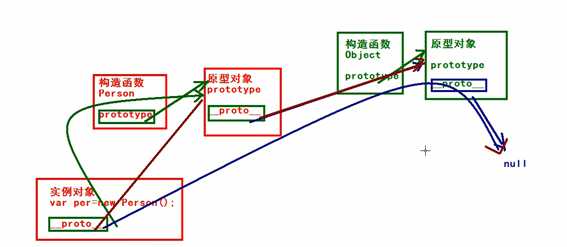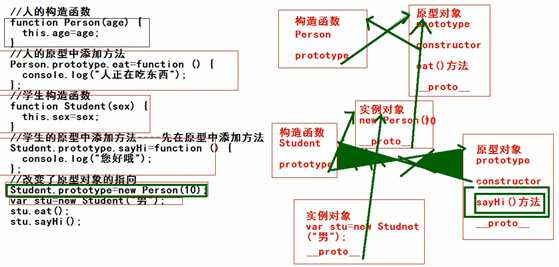为什么会出现原型?
为了解决构造函数实例化对象时造成的内存空间浪费的问题。
原型的作用?
1.资源共享,节省内存空间
2.用于模拟继承
什么是原型?
构造函数.prototype ---> 原型对象
实例化对象.__proto__ ---> 原型对象
function Person(name,age){ this.name=name; this.age=age; } var per=new Person("pap",10); console.log(per); console.log(Person); console.log(per.__proto__); console.log(Person.prototype);
为什么会出现两种表示原型对象的形式?
实例化对象中有一个属性是__proto__,该属性指向的是构造函数的原型对象
构造函数中有一个属性是prototype,该属性指向的也是构造函数的原型对象
===>因此,上述两行可以得到的结论是:构造函数.prototype==实例化对象.__proto__; // true
console.log(per.__proto__==Person.prototype); // true
原型的简单应用:
function Person(age,sex) { this.age=age; this.sex=sex; } //通过构造函数的原型添加一个方法 Person.prototype.eat=function () { console.log("明天中午吃完饭就要演讲,好痛苦"); }; var per=new Person(20,"男"); per.eat(); //明天中午吃完饭就要演讲,好痛苦
构造函数,实例对象,原型对象之间的关系
构造函数实例和初始化一个实例对象,原型对象用来添加公共的属性和方法.
每个构造函数(constructor)都有一个原型对象(prototype),原型对象都包含一个指向构造函数的指针,而实例(instance)都包含一个指向原型对象的内部指针.
利用原型共享数据
function Student(name,age,sex) { this.name=name; this.age=age; this.sex=sex; } //所有学生的身高都是188,所有人的体重都是55 //所有学生都要每天写500行代码 //所有学生每天都要吃一个10斤的西瓜 //原型对象 Student.prototype.height="188"; Student.prototype.weight="55kg"; Student.prototype.study=function () { console.log("学习,写500行代码,小菜一碟"); }; Student.prototype.eat=function () { console.log("吃一个10斤的西瓜"); }; //实例化对象,并初始化 var stu=new Student("晨光",57,"女"); console.dir(Student); console.dir(stu);
【注意】原型在自己定义的时候需要添加构造器constructor
//简单的原型写法 --> 将属性和方法都写在一起 Student.prototype = { //手动修改构造器的指向 constructor:Student, height: "188", weight: "55kg", study: function () { console.log("学习好开心啊"); }, eat: function () { console.log("我要吃好吃的"); } };
什么是原型链?


【举个栗子】:
function Father(){ this.property = true; } Father.prototype.getFatherValue = function(){ return this.property; } function Son(){ this.sonProperty = false; } //继承 Father
// Son.constructor指向的是Father Son.prototype = new Father();//Son.prototype被重写,导致Son.prototype.constructor也一同被重写 Son.prototype.getSonVaule = function(){ return this.sonProperty; } var instance = new Son(); alert(instance.getFatherValue());//true
function Father(){ this.colors = ["red","blue","green"]; } function Son(){ Father.call(this);//继承了Father,且向父类型传递参数 } var instance1 = new Son(); instance1.colors.push("black"); console.log(instance1.colors);//"red,blue,green,black" var instance2 = new Son(); console.log(instance2.colors);//"red,blue,green" 可见引用类型值是独立的
function Person(name, age, sex, weight) { this.name = name; this.age = age; this.sex = sex; this.weight = weight; } Person.prototype.sayHi = function () { console.log("您好"); }; function Student(name,age,sex,weight,score) { //借用构造函数 Person.call(this,name,age,sex,weight); this.score = score; } var stu1 = new Student("小明",10,"男","10kg","100"); console.log(stu1.name, stu1.age, stu1.sex, stu1.weight, stu1.score); var stu2 = new Student("小红",20,"女","20kg","120"); console.log(stu2.name, stu2.age, stu2.sex, stu2.weight, stu2.score); var stu3 = new Student("小丽",30,"妖","30kg","130"); console.log(stu3.name, stu3.age, stu3.sex, stu3.weight, stu3.score);
原文:https://www.cnblogs.com/exo-l/p/11707471.html